ADATA at CES 2018: A 1U AIC Server for 5G Comms, with 36x 8TB M.3 Drives
by Ian Cutress on January 16, 2018 1:00 PM EST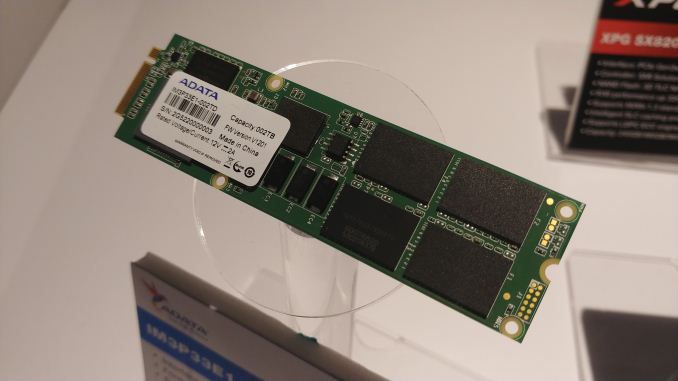
LAS VEGAS, NV – I had no idea what an M.3 drive was until I visited ADATA at CES. Having lived through IDE, SATA, and now M.2, I had never put much thought into what the next physical storage implementation would be, but M.3 has a nice ring to it.
The M.3 drive on display was listed as IM3P33EI – an enterprise level component name for a 2TB drive using PCIe 3.0 x4, supporting NVMe 1.3, LDPC ECC, and RAID engines. One of the prominent features on the drive was for live hot swap with what is a PCIe drive, allowing the drive to be used in the 1U server. The drive was using a Silicon Motion SM2262G controller, and in the server designed by AIC there were 36 M.3 hot-swappable slots for a set. The information on the drive showed that it would be available up to 1920GB, however we were told that the form factor and server should be sufficient to take up to 8TB per M.3 module.
The server was described to us as a custom design specifically for Samsung by AIC for 5G communications, using two Intel Xeon Scalable processors, up to 12 memory slots per processor, dual redundant hard drives, and in order to be able to control 144 PCIe lanes for the storage drives, dual PCIe switches. It was unclear which model of PCIe switch was being used due to the heatsinks, however I would suspect that these were PLX9000 series (probably 9290 models) which are not cheap. We were told that a fully kitted out server would have a ‘list’ price (note, this is a product specifically for Samsung) of around $250,000. It is half-surprising that the drives are not Samsung, though.
So despite being in awe for a couple of minutes, my amazement at seeing an ‘M.3’ drive was short lived. It turns out that this drive is not actually called ‘M.3’ at all: Samsung initially tried to market this form factor, a competitor to Intel’s ‘ruler’ storage form factor, as M.3 but PCI-SIG was not having any of it. So despite what it said at ADATA’s suite at CES, AIC’s specification sheet described the drive as ‘NGSFF’.


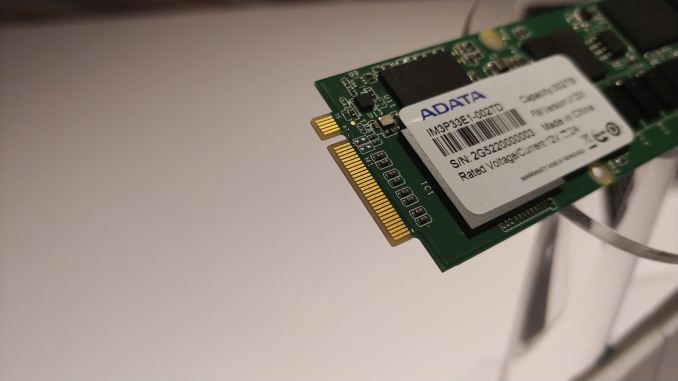
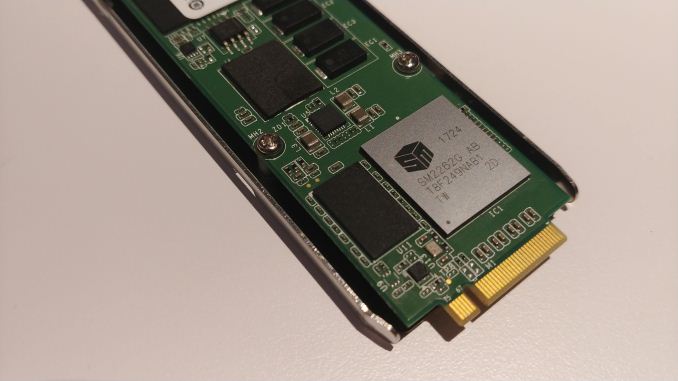
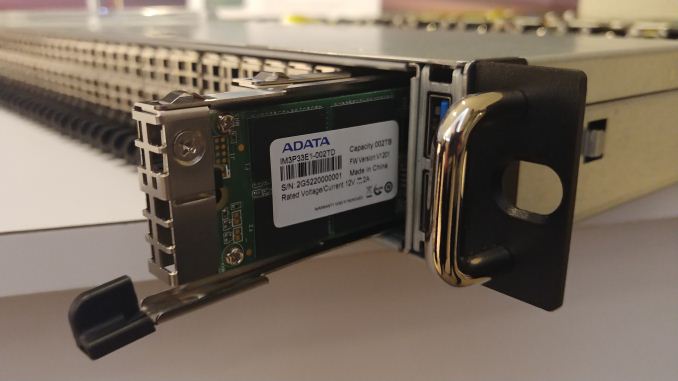






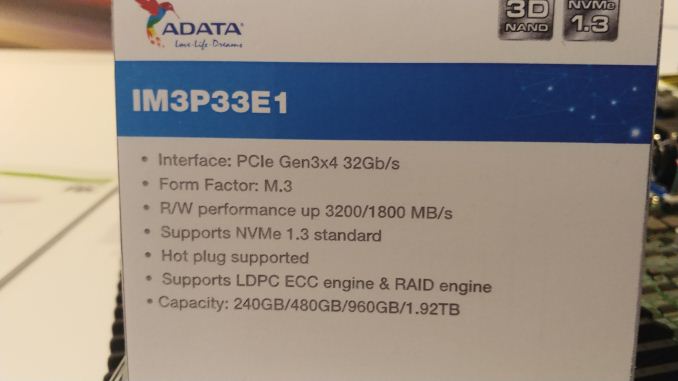
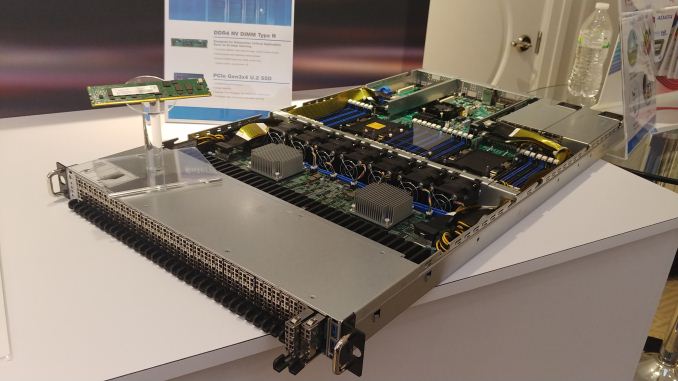








11 Comments
View All Comments
Space Jam - Tuesday, January 16, 2018 - link
Gallery works for me on desktop.vanilla_gorilla - Tuesday, January 16, 2018 - link
3:29PM CST - Gallery still broken. Including screenshot. https://i.imgur.com/xgGjsTt.pngRyan Smith - Wednesday, January 17, 2018 - link
Thanks for the heads up, Gorilla, but everything checks out on the gallery on our end.If you're still having issues, please shoot me an email, as it would require more precise troubleshooting.
edzieba - Tuesday, January 16, 2018 - link
Is "m.3" an actual standardised form-factor, or are they just using m.2 30110 and giving it made-up name in a 'higher number = more better' marketing exercise?CheapSushi - Tuesday, January 16, 2018 - link
I don't see it at all as a "higher number = more better" thing. I think it makes a lot more sense to create a distinction. Makes more sense to have a wider PCB with some of the new enterprise features be called M.3. Because M.2 is almost always associated with 22mm wide sticks. Who even makes M.2 30110? Plus it's just more numbers for no added benefit. How is that better? Or maybe you'd prefer M.2 Gen 2.2 or some other convoluted naming scheme? M.3 should just get the association with the 30+mm PCB and hotswap features etc. And YES consumers will probably get this option too. They already have problems figuring out that M.2 can be NVMe or AHCI (and has different keys). Imagine if they just called the AHCI/SATA ones M.1. Boom. Simple. Easy to tell.Kevin G - Tuesday, January 16, 2018 - link
M.3 was envisioned by Samsung as simply a wider M.2 to be to host two flash chips side by side on the narrow axis. It looks like PCI-SIG didn't like the name per the article but it looks like the Samsung backed standard is moving forward.There is another hot swap PCIe based storage called U.2 which was supposed to take off with Sky Lake-C due to the increase in host PCIe lanes and VROC. It reuses the 2.5" form factor with a SAS-like connector.
Any further storage formats will have to consult R2-D2.
The_Assimilator - Tuesday, January 16, 2018 - link
So M.2 = 22mm wide, "M.3" = 30mm wide. Apart from "M.3" being available now and using existing tech, Intel's "ruler" design seems to have a lot more going for it. Although the nice thing about this design is that you could theoretically use standard M.2 drives with it, if you don't want "M.3".Also, unless I'm reading wrong, those IM3P33EI drives consume 24W each, which means a fully-kitted-out server consumes 864 watts for storage alone. Yikes!
timecop1818 - Wednesday, January 17, 2018 - link
Why would a 5G communications server need so much fast storage, so they can archive and spy on all the LTE traffic??remosito - Wednesday, January 17, 2018 - link
The hot-pluggable capability is the big thing here imo. M.2 is nice and all, but no hot-pluggability is just a real no-go for enterprise usage. And the big advantage of U.2 over M.2Ev3rM0r3 - Wednesday, February 7, 2018 - link
Yeah but how many servers is this thing replacing with just the one. 800 watts for one that replaces 10? Might be quite the trade off.